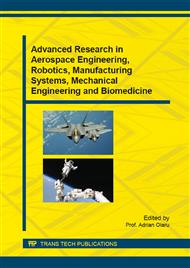p.50
p.57
p.63
p.75
p.80
p.85
p.92
p.99
p.104
Determining of the Wear Traces for Sliding Couplings
Abstract:
Abrasion wear is a mechanical process when the surfaces of a friction coupling decay and which occurs with material removal from the softer surfaces that get into contact with the asperities of the harder surface located in the space between the coupling elements. The paper aims to determine the wear trace remained on a softer surface following the slidding of a harder one, for a brass/iron coupling. The lubrication of coupling and the processing way of the coupling surfaces are factors that directly influence the tribological behaviour of the friction coupling.
Info:
Periodical:
Pages:
80-84
Citation:
Online since:
November 2015
Authors:
Price:
Сopyright:
© 2015 Trans Tech Publications Ltd. All Rights Reserved
Share:
Citation:


